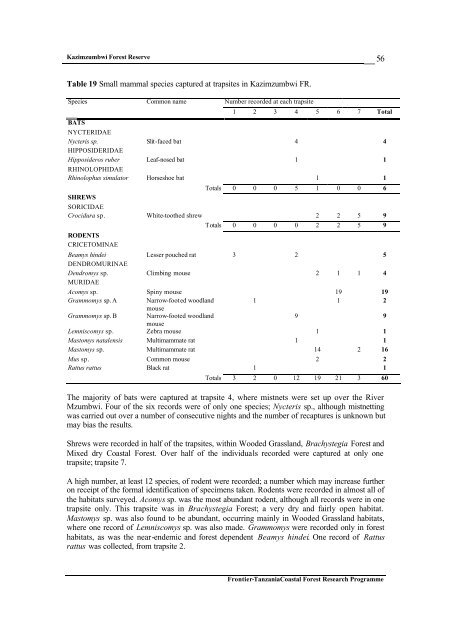Frontier Tanzania Environmental Research REPORT 110 ...
Frontier Tanzania Environmental Research REPORT 110 ...
Frontier Tanzania Environmental Research REPORT 110 ...
You also want an ePaper? Increase the reach of your titles
YUMPU automatically turns print PDFs into web optimized ePapers that Google loves.
Kazimzumbwi Forest Reserve<br />
56<br />
Table 19 Small mammal species captured at trapsites in Kazimzumbwi FR.<br />
Species Common name Number recorded at each trapsite<br />
BATS<br />
1 2 3 4 5 6 7 Total<br />
NYCTERIDAE<br />
Nycteris sp. Slit-faced bat 4 4<br />
HIPPOSIDERIDAE<br />
Hipposideros ruber Leaf-nosed bat 1 1<br />
RHINOLOPHIDAE<br />
Rhinolophus simulator Horseshoe bat 1 1<br />
SHREWS<br />
Totals 0 0 0 5 1 0 0 6<br />
SORICIDAE<br />
Crocidura sp. White-toothed shrew 2 2 5 9<br />
RODENTS<br />
CRICETOMINAE<br />
Totals 0 0 0 0 2 2 5 9<br />
Beamys hindei Lesser pouched rat 3 2 5<br />
DENDROMURINAE<br />
Dendromys sp. Climbing mouse 2 1 1 4<br />
MURIDAE<br />
Acomys sp. Spiny mouse 19 19<br />
Grammomys sp. A Narrow-footed woodland<br />
1 1 2<br />
mouse<br />
Grammomys sp. B Narrow-footed woodland<br />
9 9<br />
mouse<br />
Lemniscomys sp. Zebra mouse 1 1<br />
Mastomys natalensis Multimammate rat 1 1<br />
Mastomys sp. Multimammate rat 14 2 16<br />
Mus sp. Common mouse 2 2<br />
Rattus rattus Black rat 1 1<br />
Totals 3 2 0 12 19 21 3 60<br />
The majority of bats were captured at trapsite 4, where mistnets were set up over the River<br />
Mzumbwi. Four of the six records were of only one species; Nycteris sp., although mistnetting<br />
was carried out over a number of consecutive nights and the number of recaptures is unknown but<br />
may bias the results.<br />
Shrews were recorded in half of the trapsites, within Wooded Grassland, Brachystegia Forest and<br />
Mixed dry Coastal Forest. Over half of the individuals recorded were captured at only one<br />
trapsite; trapsite 7.<br />
A high number, at least 12 species, of rodent were recorded; a number which may increase further<br />
on receipt of the formal identification of specimens taken. Rodents were recorded in almost all of<br />
the habitats surveyed. Acomys sp. was the most abundant rodent, although all records were in one<br />
trapsite only. This trapsite was in Brachystegia Forest; a very dry and fairly open habitat.<br />
Mastomys sp. was also found to be abundant, occurring mainly in Wooded Grassland habitats,<br />
where one record of Lemniscomys sp. was also made. Grammomys were recorded only in forest<br />
habitats, as was the near-endemic and forest dependent Beamys hindei. One record of Rattus<br />
rattus was collected, from trapsite 2.<br />
<strong>Frontier</strong>-<strong>Tanzania</strong>Coastal Forest <strong>Research</strong> Programme

















